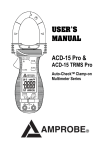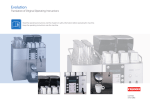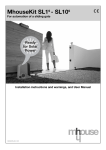Download USER´S MANUAL
Transcript
Focus series User’s manual Focus series User’s manual FOCUS INFRARED SAFETY BARRIERS Focus 4 series Type 4 Focus 2 series Type 2 The FOCUS Safety barrier complies with CE provisions according to the following directives: -98/37/EC Machinery Directive -73/23/EEC Low-Voltage directive resp. 93/68/EEC -EN 61496-1:1997 -prEN 61496-2:1997 -DIN V VDE 0801:1990 and amendment A1:1994 -EN 50081-2:1993 -EN 55022:1998 -EN 60204-1:1997 (as applicable) The barrier is certified by TUV to safety standard EN 61496-1/2 Type 2/4 USER´S MANUAL MANUFACTURER: JOKAB SAFETY AB Boplatsgatan 3 213 76 Malmö SWEDEN Tel. +46 (0)40 143630 FAX. +46 (0)40 229288 E-Mail [email protected] USER’S MANUAL: Version 1.3 dated 28-04-2003 Focus series User’s manual Focus series User’s manual 11 FINAL CHECKS............................................................................... 31 INDEX 12 ROUTINE CHECKS AND MAINTENANCE..................................... 31 Section Page 13 GENERAL INFORMATION AND USEFUL DATA .......................... 32 1 BEFORE USE .................................................................................... 5 14 TECHNICAL SPECIFICATIONS FOR FOCUS ............................... 33 2 GENERAL DATA AND MAIN APPLICATIONS................................ 6 15 MF-T AND MF-L MECHANICAL DATA .......................................... 34 3 OPERATION ...................................................................................... 7 16 DIMENSIONS ................................................................................... 34 PRECAUTIONS AND CRITERIA FOR INSTALLATION .................. 8 17 NOTES: ............................................................................................ 36 4 4.1 CALCULATION OF THE MINIMUM DISTANCE FOR INSTALLATION ................. 8 4.2 REFLECTING SURFACES ................................................................................... 10 5 MECHANICAL ASSEMBLY ............................................................ 11 6 CONNECTIONS............................................................................... 12 6.1 CABLE REFERENCES: ........................................................................................ 12 6.2 CONNECTIONS WITH SAFETY RELAY:............................................................. 13 6.3 NOTES ON CONNECTIONS ................................................................................ 15 6.4 CODES AND SPECIFICATIONS OF AVAILABLE MODELS ............................... 16 7 ALIGNMENT PROCEDURE............................................................ 18 8 OPERATING PROCEDURES ......................................................... 18 8.1 SETTING THE INTERNAL DIP-SWITCHES IN THE RECEIVER UNIT............... 18 8.1.1 SELECTION OF RESET MODE. .................................................................. 19 9 MUTING, OVERRIDE AND FLOATING BLANKING FUNCTIONS 20 9.1 GENERAL INFORMATION ON THE THREE FUNCTIONS ................................. 20 9.2 MUTING FUNCTION ............................................................................................ 20 9.3 DESCRIPTION OF SINGLE MODULE MUTING AND MODULAR MUTING ....... 21 9.3.1 DEFINITION OF MODULE............................................................................ 21 9.3.2 SINGLE MODULE MUTING AND MODULAR MUTING. ............................. 22 9.3.3 SELECTION OF MODULAR MUTING MODE ............................................. 22 9.3.4 SELECTION OF SINGLE MODULE MUTING.............................................. 22 9.4 CRITERIA FOR INSTALLATION .......................................................................... 23 9.4.1 MUTING ACTUATOR UNITS MF-T AND MF-L............................................. 26 9.5 TIMING CONSTRAINTS (muting function) ........................................................... 26 9.6 OVERRIDE............................................................................................................ 27 9.6.1 ENABLING THE OVERRIDE FUNCTION .................................................... 27 9.7 FLOATING BLANKING ......................................................................................... 27 9.7.1 DEFINITION OF FLOATING BLANKING .................................................... 27 9.7.2 MEMORISATION PROCEDURE FOR FLOATING BLANKING .................. 28 10 LED DIAGNOSTICS ........................................................................ 29 10.1 WHAT THE LEDS MEAN...................................................................................... 29 10.2 ERRORS SIGNALLED BY LED INDICATION ...................................................... 30 3 While every effort has been taken to ensure the accuracy of the information contained in this manual JOKAB SAFETY cannot accept responsibility for errors or omissions and reserves the right to make changes and improvements without notice. It is the users responsibility to ensure that this equipment is correctly designed, specified , installed, cared for and operated to meet all applicable local, national and international codes/regulations. Technical data given in this manual is correct to the level of accuracy of JOKAB SAFETY’s test procedures as verified by various international approved bodies. Other information (such as application examples, wiring diagrams, operation or use) is intended solely to illustrate the various uses of our products. JOKAB SAFETY does not guarantee or imply that the product when used in accordance with such examples in a particular environment will fulfil and particular safety requirement and does not assume any responsibility or liability for actual use of the product based on the examples given. Printed in Sweden. 4 Focus series 1 User’s manual BEFORE USE Focus series 2 • GENERAL INFORMATION Before using the Focus barriers all personnel responsible for the installation and operation of this equipment must ensure that they have read and are conversant with the information contained in this manual. It is essential that the Safety Barriers are operated and installed in accordance with the instructions in this manual. All relevant standards and regulations regarding the use of this type of device must also be strictly adhered to. The barrier does not contain any parts that are subject to maintenance. In all cases however, the power supply must be disconnected before proceeding with any internal examination/intervention. In case of malfunction, the barrier must be sent to our laboratories with a description of the anomaly found and the length of time the unit has been in service. • REGULAR MAINTENANCE Except for the cleaning of the polycarbonate front covers that protect the optical elements, the barrier does not contain any parts that are subject to maintenance. The system however should be regularly checked and inspection results recorded. Do not use woollen cloths or solvents or any material that could scratch or attack the front cover polycarbonate surface. The interval between cleaning will depend upon the local environmental conditions in which the barrier is operating. Note. Any deterioration in the protection covers e.g. by dirt etc. will not compromise the system’s safety in any way but may cause the barrier to stop operating. User’s manual GENERAL DATA AND MAIN APPLICATIONS Focus units are safety barriers for use in environments where it is essential to safeguard the safety of the operator using machinery, robots or other dangerous automated systems, and where casual and/or unauthorised access may be gained to hazardous parts. The barriers provide coverage of the protected area by the generation of infrared beams, which are able to detect an object located within their field of operation. The barriers comply with the requisites for Type 2 (Focus 2 series), and Type 4 (Focus 4 series) safety devices according to the provisions of the latest international regulations and IEC 61496 1-2 in particular. Models are available that provide protection heights of between 150 mm and 1650mm. All the control and command function electronics are contained within the profile housing; external connections being made via a M12 connector situated at the end of the barrier. There are no connections between the transmitter and the receiver, as synchronisation between the two units is achieved optically. Control and management of the beams transmitted and received is achieved by two microprocessors that also provide information on the status of the barrier via several led indicators. There are two alignment leds to aid installation. The muting and override functions are available on all the Focus barrier models and are enabled by simply connecting the LMS warning light, which is available separately. Versions are also available with the floating blanking function: this function offers the possibility to partially exclude a predetermined ‘floating’ portion of the barrier. Note. Muting, override and floating blanking all effectively override the system and therefore certain precautions must be put in place to limit the degradation of the level of safety when these functions are operational. Jokab Safety AB does not accept any liability for damage or injury due to incorrect use of the protection barriers or associated components. 5 6 Focus series 3 User’s manual Focus series User’s manual Please remember that by enabling/disabling the muting function the override function is automatically enabled/disabled. OPERATION The barrier consists of two units, one with transmitting optical elements (Transmitter) and one with receiving optical elements (Receiver). All the photosensitive elements are regularly scanned in sequence so that any objects placed between the transmitter and the receiver are detected. Upon detection the operation of the equipment being controlled is interrupted by means of the switching of the safety barrier outputs. Barrier response times vary from 14 to 45ms according to the model. Led indicators display the operating status of the machinery as well as any anomalies in the reset, test and muting inputs (for the models with this option). The operator has a multifunction pushbutton, which is used for the following: • TEST: If pressed during normal operation, it checks that all the system, comprising the barrier and the machinery interface, is operating correctly. Pressing the button (opening contact) basically simulates the interruption of one or more of the safety barriers beams making it possible to check that the machinery stops in the time and way set. • RESTART: If pressed after the barrier has detected an object, (manual reset condition) the system will be reset providing there is no obstruction of the barrier beams • ALIGNMENT: If the button is pressed when there is no power supply to the barrier and then power is restored, (whilst the button is being pressed), the barrier enters alignment mode, i.e. it provides an indication of the centring of the top and bottom optical beams by means of two yellow leds. • OVERRIDE: (only present if the muting function is operational) If the button is pressed within 5 seconds of switching on the barrier and is kept pressed for at least 5 seconds, the barrier’s outputs will switch only if the beams are interrupted. This condition stops as soon as the button is released or automatically after 120 seconds. 1. Automatic reset: After the barrier has detected an object, it will return to normal operation as soon as the object is removed. 2. Manual reset: Normal operating mode is only restored after the object has been removed and the reset button has been pressed. To enable the muting function, the LMS muting indicator must be connected when the barrier is not connected to the power supply, as shown in section 6, and then the barrier’s power supply must be restored. To disable the muting function, the LMS muting indicator must be disconnected when the barrier is not connected to the power supply, and then the barrier’s power supply restored. 7 The outputs of the safety barrier are PNP transistors. Should the load to be controlled have alternating current or require more than 500mA consumption, a safety relay is necessary, this converts the transistor outputs into relay contact outputs whose operation is directly tested and controlled by the safety relay module itself. 4 PRECAUTIONS AND CRITERIA FOR INSTALLATION The area where the barrier is to be installed must be compatible with the device technical specifications. The temperature of the environment, interference caused by electromagnetic disturbance and sources of light etc, should be assessed prior to the installation of the barrier. 4.1 CALCULATION OF THE MINIMUM DISTANCE FOR INSTALLATION The safety distance ‘S’ is the minimum distance that must be maintained between the safety barrier and the dangerous area/position of the machine. The safety distance must guarantee that the operator cannot reach the danger zone before the machines moving parts have stopped. The formula to calculate the safety distance for multi-beam barriers is as follows: S=(K*T)+C S T = Safety distance. = T1 + T2 where T1 = machinery’s response time in seconds. T2 = barrier’s response time in seconds. = approach speed of the body to the danger zone: 2000 mm/s for Fx-14 or 35 models, 1600mm/s for Fx-K models =8*(d-14)mm for Fx-14 or 35 models, 850 mm for Fx-K models where d is the minimum object that can be detected (35mm for Fx-35 and 14mm for Fx-14) K C S H2 H1 S = safety distance. H1 = the bottom beam must not have a height above 300 mm . H2 = the top beam must not be below 900 mm . 8 Focus series User’s manual The Focus Fx-K series has beams set to meet the accepted standards. Please note the required bottom beam height (1st beam height) from the floor in the following table. 4 Beams Beam height (900 unit) from floor 1st Beam height 300 mm 4 Beams (1200 unit) 300 mm 3 Beams 2 Beams 300 mm 400 mm 2nd Beam height 600 mm 700 mm 700 mm 900 mm 3rd Beam height 900 mm 1100 mm 1100 mm 4th Beam height 1200 mm 1500 mm Focus series User’s manual 4.2 REFLECTING SURFACES Should there be any reflecting surfaces close to the safety barrier, the clearance distance must be sufficient to safeguard against passive reflections. The distance can be calculated with the formula: A = 0.04366 * L where ‘A’ and ‘L’ are expressed in mm Reflecting material FR unit FT unit A 2,5° 2,5 If the barrier is installed in a horizontal position the distance between the danger zone and the furthest beam must be equal to the result of the calculation using the previous formula, but with the following parameters: Object A Reflecting surface S=(K*T)+C L T= T1 + T2 where K C H T1 = machinery’s response time in seconds. T2 = barrier’s response time in seconds. = 1600 mm/s (approach speed of the body to the danger zone). = 1200 - 0.4 * H. = height (in mm) of the optical beams compared to the floor. RX FRbarunit FT TX unit bar L object S 2,5° A Reflecting surface H S = safety distance. H = the optical beam must have a height between 225 mm and 1000mm. 9 10 Focus series User’s manual If several barriers are used, care must be taken that each transmitter does not interfere with the receiver of a nearby barrier. Barriers should be installed as below: TRANSMITTER FT unit 5 RECEIVER FR unit RECEIVER FR unit Focus series 6 6.1 User’s manual CONNECTIONS CABLE REFERENCES: TRANSMITTER FT unit MECHANICAL ASSEMBLY Use the appropriate brackets provided to complete the mechanical assembly. The fixing brackets for the transmitter/receiver units slide in the profile slots so that they can be placed at an equal distance from each other. OK NO NO Note. A N/C. voltage free contact from a button or an automatic device, such as a PLC, must be connected across the Test/Restart input 1. 11 12 Focus series 6.2 User’s manual Focus series User’s manual Connection scheme if a safety relay is connected to the muting activator unit MF-L or MF-T which is added to the safety barrier. CONNECTIONS WITH SAFETY RELAY: Note. Do not make the connections shown in bold type if the muting function is not required. Test/Restart pushbutton no 1. has a multifunction (see Section 3 Operation Page 7). Normally this is the button to use and button no 2 is bypassed. The safety relay is connected for (*) automatic reset. Test/Reset pushbutton no 2. Safety Relay Manual reset. This button can be used if the barrier is set internally for automatic restart and button 1. Is bypassed or connected and used for alignment only. Test/Restart pushbutton no 1. has a multifunction (see Section 3 Operation Page 7). Normally this is the button to use and button no 2 is bypassed. The safety relay is connected for (*) automatic reset. Test/Reset pushbutton no 2. – Safety Relay Manual reset. This button can be used if the barrier is set internally for automatic restart and button 1. Is bypassed or connected and used for alignment only. Notice: both buttons can not be used at the same time. Notice: both buttons can not be used at the same time. 13 14 Focus series 6.3 User’s manual Focus series User’s manual NOTES ON CONNECTIONS 6.4 • The columns “Number of modules” and “Number of optical beams per module” refer to muting operation management (see section 9.3). • • • • • Power to the system must be by a 24V DC supply which complies with standard EN 60742 (dual isolation), or with equivalent isolation, e.g. VDE 0551. The light barrier must be protected with an external fuse having a rated breaking current of 1A normal The TEST/RESTART button must be located so that the operator can see the protected area when restarting, testing or overriding. The external illuminated indicator for ‘muting override’ enabled must be located so that it can be seen from all sides of the machine operation. Read Section 9 on the muting function and its use before locating the sensors for the activation of this function. Check that the load to be switched by the barrier’s PNP transistor outputs does not exceed 500 mA. A protection device will automatically limit output current to 500 mA. If loads with currents in excess of 500mA and up to 6A, and/or alternating current are to be switched, a safety relay must be connected to the outputs as shown in Section 6.2 15 CODES AND SPECIFICATIONS OF AVAILABLE MODELS The following table shows the standard models available in the Focus Fx-14 series, based on the barriers protection length and operating features. All the models in the Focus Fx-14 series guarantee 14 mm resolution. Models Protection length (mm) Total length (mm) L Total number of optical beams Response time (ms) Number of modules Number of optical beams per module Fx-14-150 150 247 21 15 7 3 Fx-14-300 300 350 42 18 7 6 Fx-14-450 450 497 63 22 7 9 Fx-14-600 600 644 84 24 6 14 Fx-14-750 750 791 105 27 7 15 Fx-14-900 900 938 126 30 6 21 Fx-14-1200 1200 1232 168 36 8 21 Fx-14-1500 1500 1526 210 42 10 21 Fx-14-1650 1650 1673 231 45 11 21 16 Focus series User’s manual The following table shows the standard models available in the Focus Fx-35 series, based on the barriers protection length and operating features: All models in the Focus Fx-35 series guarantee 35 mm resolution. Models Protection length (mm) Total length (mm) Response time (ms) Number of modules L Total number of optical beams Number of optical beams per module Fx-35-150 150 247 8 14 4 2 Fx-35-300 300 350 16 14 4 4 Fx-35-450 450 497 24 16 4 6 Fx-35-600 600 644 32 16 4 8 Fx-35-750 750 791 40 18 5 8 Fx-35-900 900 938 48 20 6 8 Fx-35-1200 1200 1232 64 22 4 16 Fx-35-1500 1500 1526 80 24 5 16 Fx-35-1650 1650 1673 88 26 4 22 Focus series 7 The following table shows the standard Grid series: Models Protection length (mm) Total height (mm) L ALIGNMENT PROCEDURE After completing correct mechanical assembly and connections, as described in the previous sections, the barrier should be aligned as follows: • • • • • • • • 8 (1) User’s manual Disconnect the barrier’s power supply. Open the test/restart contact 1 . Restore the barrier’s power supply. Adjust the direction of the barrier by moving the receiver or transmitter. The 2 yellow leds located on the receiver will both be lit when the barrier is aligned correctly. After aligning the barrier, secure the bolts firmly. Disconnect the power supply. Restore the barrier’s power supply (with the test/restart contact closed); it will enter operating mode. Complete all the checks described in Section 11 “Final Checks” and Section 12 “Routine Checks and Maintenance”. OPERATING PROCEDURES models available in the Focus Fx-K 8.1 Total number of optical beams Response time (ms) Number of modules Number of optical beams per module Fx-K2-500 500 599 2 14 2 1 Fx-K3-800 800 899 3 14 3 1 Fx-K4-900 900 999 4 14 4 1 Fx-K4-1200 1200 1299 4 14 4 1 (1) Many protected lengths not included in the list of standard models can be supplied on request. SETTING THE INTERNAL DIP-SWITCHES IN THE RECEIVER UNIT • • Disconnect the barrier’s power supply and remove the Receiver’s end cap that has the M12 connector fitted, so that the two banks of dip-switches can be reached. Use a suitably sized screwdriver to set the dip-switches as per the required configuration according to the following tables. OFF ON 1 2 3 4 OFF ON 1 2 3 4 The switches are: 1 2 3 4 OFF OFF OFF ON Note. The two dip-switch banks in the receiver must be set in the same configuration. Switch default settings set by the factory are : Switches No’s.1, 2 and 3 OFF, Switch No.4 ON. 17 18 Focus series 8.1.1 User’s manual SELECTION OF RESET MODE. Switch No. 4 Reset OFF ON Manual Automatic Focus series User’s manual 9 MUTING, OVERRIDE AND FLOATING BLANKING FUNCTIONS 9.1 GENERAL INFORMATION ON THE THREE FUNCTIONS The muting, override and floating blanking functions enable the barrier (or a part of it) to be bypassed for operational requirements. As required by current standards, the barrier is provided with the necessary inputs for the activation of these functions. It should however be remembered that these functions basically override the system and they should therefore be used with due care. 9.2 MUTING FUNCTION As previously mentioned, the muting function can be enabled on any barrier by simply connecting the LMS muting indicator when the barrier is switched off, as described in section 6. The presence of the LMS indicator is recognised when the barrier is switched on. If its presence is detected, the barrier will enable the muting function, if its presence is not detected the barrier will ignore any request for muting. It is important to note that if the muting indicator is connected when the barrier is already connected to the power supply, it will not be recognised and the muting function will not be enabled. Once enabled, if the indicator develops a fault or is removed without first disconnecting the barrier’s power supply, it will signal an error with the muting light, as described in section 10. To disenable the muting function, therefore, the barrier’s power supply must be turned on without the LMS muting indicator being connected. In brief, this function, present on all barriers, is enabled and disenabled by means of the following simple procedures: To enable the muting function :- Disconnect the barrier’s power supply. - Connect the LMS indicator and the muting sensors (see Section. 6 ) - Restore the barrier’s power supply. To disable the muting function:Disconnect the barrier’s power supply. - Disconnect the LMS indicator and the muting sensors ( see Section. 6 ) - Restore the barrier’s power supply. 19 20 Focus series 9.3 User’s manual DESCRIPTION OF SINGLE MODULE MUTING AND MODULAR MUTING With this series of barriers it is possible to specify single module muting or modular muting (Switch No.3 Receiver). 9.3.1 DEFINITION OF MODULE. A Module is a section of the barrier whose size contains the amount of optical beams defined in the table in section 6. For example, a Focus Fx-35-600 should be considered as 4 adjacent modules, each containing 8 optical beams giving a total of 32 optical beams, whereas a Focus Fx-14-300 should be considered as 7 adjacent modules, each containing 6 optical beams giving a total of 42 optical beams. Various configurations can be achieved on request, according to requirements. Focus series User’s manual 9.3.2 SINGLE MODULE MUTING AND MODULAR MUTING. Single module muting enables only one module at a time to be made transparent, whereas modular muting makes it possible to make two or more modules transparent, until even the whole barrier has been bypassed. Should a muting request be made for modules that do not exist when in single module muting mode (for example bypassing of the 4th module with a barrier that only has three), the barrier will remain operational. Please note that in single module muting it is not possible to select the module containing the synchronisation optical beam which is situated at the opposite end of the barrier to the M12 connector. In this case the muting function will not work. Should a modular muting request also involve modules that do not exist (for example muting of modules 1+2+3+4 with a barrier that only has three), the barrier will enter total muting mode Switch settings for the various muting modes are as follows: 9.3.3 SELECTION OF MODULAR MUTING MODE Switches in Receiver unit Modular muting The layout of the modules is illustrated below: No.1 OFF OFF ON ON Nth module 4th module No.2 OFF ON OFF ON No.3 OFF OFF OFF OFF Muting of all modules (standard setting) Muting of modules 1+2+3+4 Muting of modules 1+2+3 Muting of modules 1+2 9.3.4 SELECTION OF SINGLE MODULE MUTING Switches in Receiver unit Muting of single module 3rd module No.1 OFF OFF ON ON 2nd module No.2 OFF ON OFF ON No.3 ON ON ON ON Muting of module 1 Muting of module 2 Muting of module 3 Muting of module 4 WARNING 1st module There are two different dip-switch banks in the Receiver unit, both of these must be set in the same way. Connector Connector • 21 The modular muting function, with all modules activated ( Switches 1,2 and 3 set in the OFF position ) is the factory default setting. 22 Focus series 9.4 User’s manual Focus series User’s manual 1. Application with two sensors: CRITERIA FOR INSTALLATION Connection of the muting sensors: Direction allowed All the muting sensors must be connected correctly in order to prevent their incorrect placement from causing undesired requests for muting. 1. The muting sensors must recognise the whole length of the material (i.e. pallets, vehicles, etc). 2. The sensors must be arranged so that the material is always recognised throughout its transit through the protection barrier (grid/curtain). 3. The effect of various material transportation speeds during the duration of muting must be taken into account. 4. The safety barrier (grid/curtain) and muting sensors must be arranged so that the previous material clears the last muting sensor before the new material reaches the first sensors. 24 VDC MUTE A IN Contact with A B MUTE B IN A S to the Focus cable d1 = D Contact with B 2. Application with four sensors and single direction for introduction of material: Connection of the muting sensors: 24 VDC Direction allowed to the Focus cable Contact with A1 L v S B2 A2 B1 A1 S Contact with A2 MUTE A IN Contact with B1 MUTE B IN d1 D Contact with B2 B2 A2 B1 A1 3. Application with four sensors and dual direction for introduction of material: Connection of the muting sensors: Installation example of barrier protection across a conveyor, which must allow a box to pass through, but not a person. The protection barrier S is connected to the control panel, and A1, A2, B1 and B2 sensors detect the passage of the box and enable the muting function. The contacts from these sensors are connected to the protection barrier receiver unit. Sensors A and B can be optical, mechanical, proximity sensors, etc., having closed voltage free contact when an object is detected. The following pages show several examples of configurations using the muting function: Directions allowed 24 VDC Contact with A1 L A2 B2 S B1 A1 to the Focus cable Contact with A2 MUTE A IN Contact with B1 MUTE B IN d1 D Contact with B2 23 24 Focus series User’s manual Where: D= d1 = minimum distance for the muting sensors to keep the request operational; depends on the length of the box: D < L. maximum distance required for the muting request to be accepted; depends on the speed of the box: dmax [cm]= v[m/s] * 3[s] * 100 It is essential that this distance does not allow both sensors to be activated (at the same time) and thus muting if a person passes through by accident. Muting lamp Start & Test buttons Cable to lamp Supply Cable Muting cable Protect cables FR cable FT cable Focus series 9.4.1 MUTING ACTUATOR UNITS MF-T AND MF-L The MF-T and MF-L Muting adaptor units have been designed to be used with the Focus barriers when it is required to mute the protection barrier as shown in the previous examples. No extra sensors are required as the Muting adaptor units have all necessary components integrated and connected within the aluminium profile housing. All that is required is to physically fix the device to the barrier and make the electrical connections via the M12 connector. The MF-T version contains four photocells, A1, B1, B2 and A2 and is designed for applications where the material travels through the protection barrier either ‘in’ or ‘out’, or ‘in and out’ in both directions. These conditions are the default operations when the MF-T is used with ‘standard order’ protection barriers. See example 3 on page 24. The MF-L version contains two photocells, A1 and B1 which are physically positioned in front of the protection barrier ‘entrance’. This device is preliminary designed for muting in the ‘out’ direction but can be used in the ‘in’ direction if suitable precautions are taken. This version is available upon request together with the muted barrier. 9.5 • • • • The TEST/RESTART button must be located so that the operator can see the protected area when restarting, testing or overriding the barrier. The external illuminated indicator for muting override enabled must be located so that it can be seen from all sides of the operation. If photoelectric muting sensors are installed very close to the barrier, care must be taken that the receivers of the sensors are mounted on the transmitter side of the barrier in order to avoid interference. The system is protected against the possibility of faults occurring due to damage to the receiver/transmitter connection cables; it is however recommended that all cables are physically protected to minimise any such damage. User’s manual TIMING CONSTRAINTS (muting function) a) The muting request must take place with the correct timing sequence; the Muting A input must be enabled first and then the Muting B input. The request for the latter must be made within a maximum of 3 seconds and not before 30 ms after the enabling of the Muting A input. Unless the A and B Muting inputs are operated in the correct sequence and time constraints the muting function will not be enabled. b) Muting status can be maintained for an unlimited time according to requirements, provided the request is maintained. Muting A 30 ms min Muting B 3 s max ON Muting Status OFF OFF A muting request cannot be made if the barrier outputs are deenergised, (when the barrier beams have been interrupted). 25 26 Focus series 9.6 User’s manual OVERRIDE This function makes it possible to select a condition of total bypass, should it be necessary to start up the machinery even if one or more beams have been interrupted by material. The objective is to be able to free the protected area from any material that has accumulated in front of the barrier, e.g. after a fault in the machines cycle. If a pallet has stopped in front of the protected area, it will not be possible to restart the conveyor belt because the barrier detects one or more beams have been interrupted and therefore will not energise its outputs; the area controlled therefore cannot be liberated. The area can however be liberated if the override function is enabled. This function is active for all barriers when the LMS muting indicator is connected, as described in section 3. 9.6.1 ENABLING THE OVERRIDE FUNCTION • Switch the barrier off. • Switch it on again and press the test/restart 1 button within 5 seconds, keeping the button pressed for at least 5 seconds. • The override function is now enabled. The LMS indicator flashes to signal that barrier is being over-ridden. • The maximum duration of the override function is 120 seconds, after which the barrier is restored, even if the button is kept continually pressed. If the button is released before 120 seconds, the override function will terminate immediately. 9.7 FLOATING BLANKING To order this facility add “FB” to the order/model number of the barrier. 9.7.1 DEFINITION OF FLOATING BLANKING Floating Blanking means the permanent masking of a selected number of optical beams in a defined part of the sensitive area of the barrier. The maximum number of optical beams that can be masked depends on the total number of the optical beams in the system. This cannot be more than 30% of the total number, if however 30% corresponds to more than 20 optical beams, the system will limit the number of optical beams at its maximum number of 20. Examples are as follows: Example 1: Total number of optical beams: Focus series User’s manual Number of optical beams that can be blanked: = 31 The barrier can have more than 20 optical beams but only 20 can be masked. Example 2: Total number of optical beams: Number of optical beams that can be blanked The maximum maskable zone is 7 beams. =24 =7 9.7.2 MEMORISATION PROCEDURE FOR FLOATING BLANKING The object is memorised as follows: 1. Switch the barrier off. 2. Put the object to be detected for floating-blanking purposes into place. 3. Connect the MUTING A (green) input to 24Vdc. The test/reset 1 contact must be closed. 4. Restore the barrier’s power supply. 5. Now supply the MUTING B (yellow) input with 24Vdc. 6. The barrier signals successful memorisation of the object by the flashing of the LOWER (yellow) led which confirms acceptance of floating-blanking. If the led does not flash at this point, it means that the object takes up an amount of optical beams which is above 30% of those physically present; it should be remembered that the maximum limit is 20 optical beams. 7. Now disconnect the two MUTING A and MUTING B wires from +24Vdc. 8. The barrier works normally and signals the floating-blanking operation by the flashing of the LOWER (yellow) led on the receiver. PLEASE NOTE: The last optical beam opposite to the connector side cannot be used with the floating-blanking function, as it is the optical beam for the synchronisation between the barrier transmitter and receiver units. If floating-blanking memorisation is completed without the object, and thus with the beams free, the LOWER (yellow) led will not flash at the end of the process as the entire barrier is operational: this is a simple way to reset the floatingblanking function. If the object memorised, is for any reason removed or occupies a lesser number of optical beams than in the memorisation process, the barrier will signal the anomaly and the outputs will be de-energized. The LOWER (yellow) and BREAK (red) leds will flash to indicate this particular status. It is possible to exit this error status by pressing the TEST/RESTART button provided the object has been replaced. = 102 27 28 Focus series User’s manual Focus series User’s manual 10.2 ERRORS SIGNALLED BY LED INDICATION 10 LED DIAGNOSTICS 10.1 WHAT THE LEDS MEAN The operator is able to observe the operating status of the barrier by means of five leds located on the receiver and two leds on the transmitter. The status of the leds on the receiver indicate the following: (looking at the front of the receiver from right to left) • UP. ALIGN (Yellow): When the barrier is in alignment mode; when lit, this indicates the alignment of the optical beam located in the top section of the barrier. In normal working conditions the led is not lit and will only light up after the barrier has intervened with free beams in manual reset mode. • BREAK (Red): When lit, this indicates that the barrier has intercepted an object; the outputs are de-energised in this condition. • GUARD (Green): When lit, this indicates that there are no objects placed between the barrier transmitter and receiver units. • LO. ALIGN (Yellow): When lit, this indicates alignment of the optical beam located in the bottom section of the barrier (connector end) when the barrier is in alignment mode. If this led lights up during normal working conditions, this indicates that dust is present on the front of the barrier. If it flashes, there is a short circuit on the outputs. • POWER (Green): When lit, this indicates that the receiver is powered. If critical errors are detected by tests (automatically carried out or initiated externally) run by the barriers processors, the leds provide indication of faults/conditions found. The faults/conditions indicated are as follows: RECEIVER • • • • • Only the POWER(green) power led lit: -system power supply is too low. POWER(green) led lit and LO.ALIGN (yellow) led flashing: optical system fault. POWER(green) led lit and UP. and LO.ALIGN (yellow) leds flashing: micro controller fault. POWER (green) led, UP. and LO.ALIGN (yellow) leds and BREAK (red) led flashing: output system fault. POWER (green) led, UP. and LO. ALIGN (yellow) leds and GUARD (green) led flashing: muting lamp connection fault. TRANSMITTER • • Only the POWER(green) led is lit: system power supply is too low. POWER(green) led lit and STATUS OK (yellow) led flashing: optical system fault or micro controller fault. The leds placed on the transmitter indicate the following: • POWER (Green): when lit, this indicates that the transmitter is powered • STATUS OK (Yellow): when lit but not flashing, this indicates that the transmitter is working correctly; if it flashes or if it is off, this indicates a transmitter fault. 29 30 Focus series User’s manual 11 FINAL CHECKS Focus series User’s manual 13 GENERAL INFORMATION AND USEFUL DATA Check that the area protected by the barrier is free of obstacles. Check that when the protection beams are interrupted the barrier safety outputs operate correctly, the BREAK led is lit and the machinery under control stops. 12 ROUTINE CHECKS AND MAINTENANCE The following is a list of recommended checks/control procedures that should be carried out on a regular basis by qualified personnel: • Check that the barrier switches correctly by inserting a suitably sized object that intercepts the beams along the entire protection length; for hand protection use a Ø35mm object, for a finger protection use a Ø14mm object • Check via the opening of the TEST/RESTART contact 1, that the safety relay outputs open (red led lit and controlled machinery stopped). • Check that it is not possible to access the danger areas of the machinery from any area that is not protected by the barrier and that the minimum distance between the dangerous areas and the barrier is no less than that calculated as per formulas 4.1 and 4.2.) • Check that it is not possible for a person to get between the barrier and the dangerous parts of the machinery. • Check that there is no external damage to the barrier and/or to the external electrical connections. Note The interval between the above actions depends on the individual application and the environmental conditions where the barrier is being used. All relevant local and national regulations should be consulted for the appropriate required frequency of checks for any specific application. If in any doubt local/national safety inspectorate/bodies should be contacted for advice. For FOCUS F2 (level 2) series Jokab safety suggest once a day in normal environmental conditions. 31 Everyone MUST be aware of the issues regarding safety. It is essential that safety devices are installed correctly according to the recommendations set down by regulations. If you are not sure that you are able to install safety devices correctly, you should contact our service department or have them installed by a qualified engineer. This FOCUS barriers are provided with a 12 months warranty from the date of delivery. Faults that are clearly caused by damage due to incorrect use, accidental circumstances or catastrophic events are not covered by the company’s warranty. For all warranty claims and repairs, please return the barrier to you local JOKAB SAFETY distributor/dealer together with a description of the fault found and the period of use. 32 Focus series User’s manual 14 TECHNICAL SPECIFICATIONS FOR FOCUS • • • • • • • • • • • • • • • • • • • • • • • • • • Focus series User’s manual 15 MF-T AND MF-L MECHANICAL DATA Power supply: 24 Vdc ± 20%. Consumption: 10W max (with both FT and FR connected). Beam Emission: Infrared Leds. Beam Reception: Photodiodes. Number of emitters/receivers: according to model (see table in section 6.4). Wavelength of emitters: 950 nm. FR indicators: - 2 green leds - 2 yellow leds - 1 red led FT indicators: - 1 green led - 1 yellow led Response time: according to model (see table in section 6.4). Resolution: 14 mm for Fx-14 models. 35 mm for Fx-35.models. Variable for Fx-K models according to number of beams and protection length. Operating temperature: -10 to + 55 °C. Humidity: 15% to 95% (non condensing). Safety outputs: Two 500mA PNP transistor outputs with short circuit protection. Max. ON-state voltage: 22V Max. OFF-state voltage: 0.5V Max. Leakage current: 40µA Max. capacitive load: 0.5µF Min.cross section of cable on output: 0.25 mm2 (AWG 30) Operating distance: Fx-14: 0.2-6m, Fx-35: 0.2-15m, F2-Kx: 0.5-50m, F4-Kx: 0.5-25m or 4-50m, Fx-K1C: 0.2-6m. External controls: start/test/override button, muting inputs FR connector: M12 8-pin + screen FT connector: M12 5-pin + screen Metal housing (aluminium) painted yellow (RAL 1303 F14). Mechanical housing dimensions: 35 *45 mm Enclosure Protection Class: IP 65. Muting indicator lamp LMS: max 3 W • • • • MF-T length: 675mm MF-L length: 367mm MF-T distance between A1-B1 A2-B2: 150mm MF-T distance between A1-A2: 485mm 16 DIMENSIONS All dimensions are shown in millimetres For inductive load be sure that the resistance of the coil do not require a current higher than 500mA. 33 34 Focus series User’s manual Focus series User’s manual 17 NOTES: 45 35 L L dimension is shown in par. 6.4 35 36


















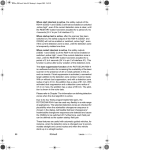
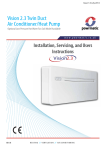

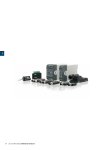




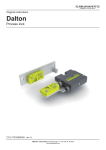



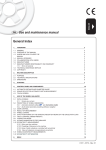

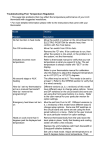
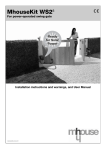
![CDNXL_60_RETAIL_SALES [MetaTexis] [Final version]](http://vs1.manualzilla.com/store/data/005704456_1-17a983fab827ed2fd4ed28ca910215ca-150x150.png)

